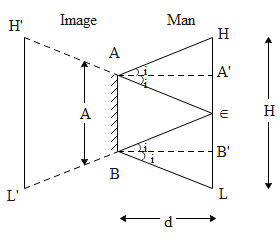
The shortest height of a vertical mirror required to see the entire image of a man, will be.
(A) One-third the man's height
(B) Half the man's height
(C) Two-third the man's height
(D) Data insufficient
Answer
216.3k+ views
Hint: We know that for a thin lens in air, the focal length is the distance from the center of the lens to the principal foci (or focal points) of the lens. For a converging lens (for example a convex lens), the focal length is positive, and is the distance at which a beam of collimated light will be focused to a single spot. The focal length of the lens is the distance between the lens and the image sensor when the subject is in focus, usually stated in millimetres (e.g., 28 mm, 50 mm, or 100 mm). In the case of zoom lenses, both the minimum and maximum focal lengths are stated, for example 18–55 mm.
Complete step by step answer
The diagram for the question is given below:

Here, $\tan {{i}_{1}}=\dfrac{{{A}^{\backslash }}E}{d}$
and we can say that $\tan {{i}_{1}}=\dfrac{{{A}^{\backslash }}H}{d}$
So, we can say that:
${{B}^{\backslash }}E={{B}^{\backslash }}L$${{A}^{\backslash }}E={{A}^{\backslash }}H$
Now we can write that:
$\begin{align}
& M=2(x+y); \\
& h=x+y; \\
& H=2h \\
\end{align}$$\tan {{i}_{2}}=\dfrac{{{B}^{\backslash }}E}{d}$
And we can say that $\tan {{i}_{2}}=\dfrac{{{B}^{\backslash }}L}{d}$
So, we can say that:
${{B}^{\backslash }}E={{B}^{\backslash }}L$
Now we can say that:
$\begin{align}
& M=2(x+y); \\
& h=x+y; \\
& H=2h \\
\end{align}$
The minimum height of the mirror to see the full image is half of the height of men.
So, the correct answer is option B.
Note: Focal length can also change the perspective and scale of your images. A lens with a shorter focal length “expands” perspective, giving the appearance of more space between the elements in your photo. Meanwhile, telephoto lenses tend to stack elements in the frame together to “compress” perspective. One of the most important aspects, when you buy a lens, is the focal length. This lets you know how close you need to be in relation to the subject you are capturing. A longer focal length is necessary for objects further away. A smaller focal length captures more of the scene in front of us.
Complete step by step answer
The diagram for the question is given below:

Here, $\tan {{i}_{1}}=\dfrac{{{A}^{\backslash }}E}{d}$
and we can say that $\tan {{i}_{1}}=\dfrac{{{A}^{\backslash }}H}{d}$
So, we can say that:
${{B}^{\backslash }}E={{B}^{\backslash }}L$${{A}^{\backslash }}E={{A}^{\backslash }}H$
Now we can write that:
$\begin{align}
& M=2(x+y); \\
& h=x+y; \\
& H=2h \\
\end{align}$$\tan {{i}_{2}}=\dfrac{{{B}^{\backslash }}E}{d}$
And we can say that $\tan {{i}_{2}}=\dfrac{{{B}^{\backslash }}L}{d}$
So, we can say that:
${{B}^{\backslash }}E={{B}^{\backslash }}L$
Now we can say that:
$\begin{align}
& M=2(x+y); \\
& h=x+y; \\
& H=2h \\
\end{align}$
The minimum height of the mirror to see the full image is half of the height of men.
So, the correct answer is option B.
Note: Focal length can also change the perspective and scale of your images. A lens with a shorter focal length “expands” perspective, giving the appearance of more space between the elements in your photo. Meanwhile, telephoto lenses tend to stack elements in the frame together to “compress” perspective. One of the most important aspects, when you buy a lens, is the focal length. This lets you know how close you need to be in relation to the subject you are capturing. A longer focal length is necessary for objects further away. A smaller focal length captures more of the scene in front of us.
Recently Updated Pages
Wheatstone Bridge Explained: Working, Formula & Uses

Young’s Double Slit Experiment Derivation Explained

JEE Atomic Structure and Chemical Bonding important Concepts and Tips

JEE Amino Acids and Peptides Important Concepts and Tips for Exam Preparation

Electricity and Magnetism Explained: Key Concepts & Applications

Chemical Properties of Hydrogen - Important Concepts for JEE Exam Preparation

Trending doubts
JEE Main 2026: Application Form Open, Exam Dates, Syllabus, Eligibility & Question Papers

Derivation of Equation of Trajectory Explained for Students

Hybridisation in Chemistry – Concept, Types & Applications

Understanding the Angle of Deviation in a Prism

Understanding Collisions: Types and Examples for Students

How to Convert a Galvanometer into an Ammeter or Voltmeter

Other Pages
JEE Advanced Marks vs Ranks 2025: Understanding Category-wise Qualifying Marks and Previous Year Cut-offs

Understanding Atomic Structure for Beginners

Ideal and Non-Ideal Solutions Explained for Class 12 Chemistry

Degree of Dissociation: Meaning, Formula, Calculation & Uses

Understanding Electromagnetic Waves and Their Importance

Understanding the Electric Field of a Uniformly Charged Ring




